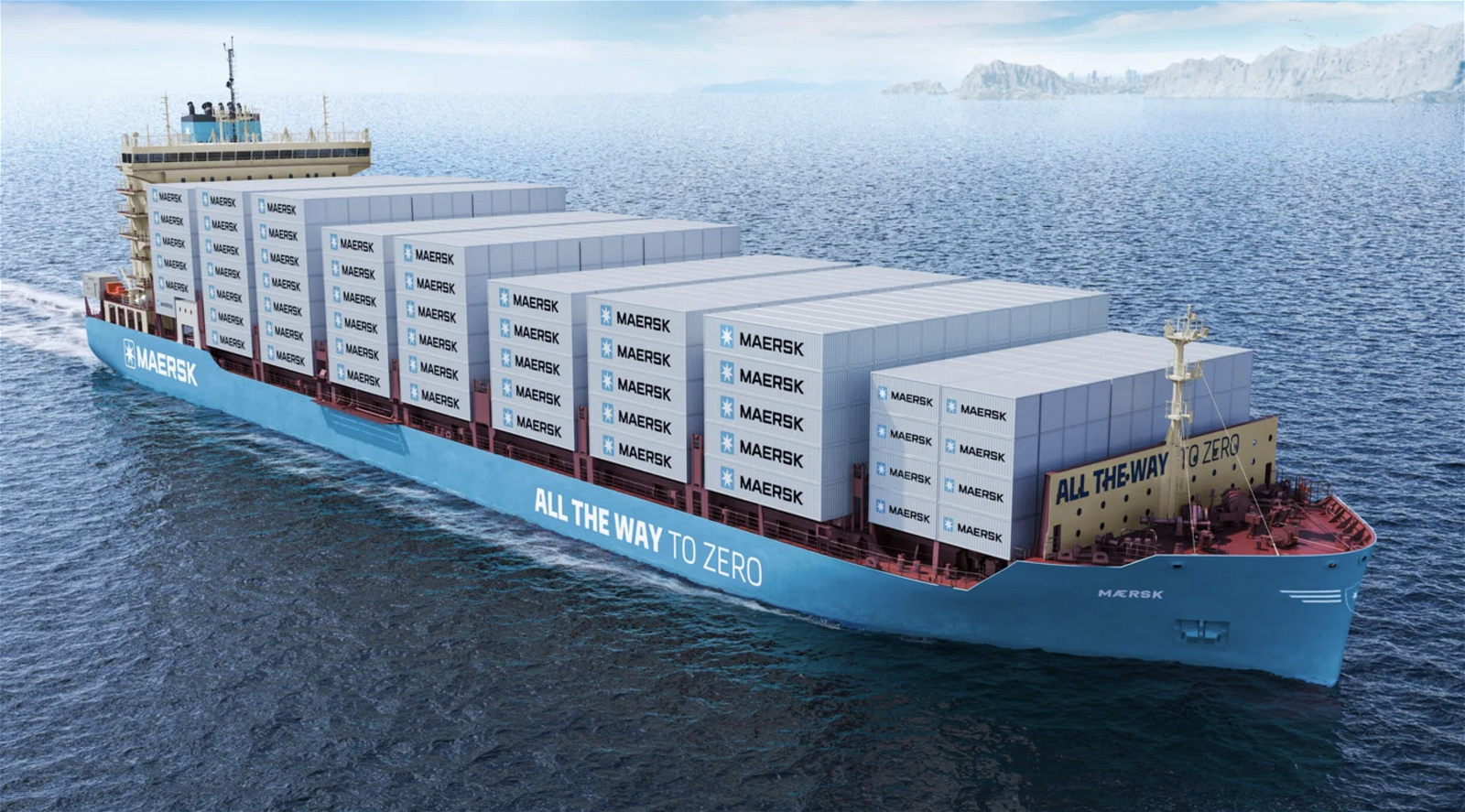· 8 min read
The push for new fuels

In March 2023, shipping giant Maersk announced the arrival of their first green methanol-ready carrier ship, with a range of festivities planned to take place in Copenhagen in September this year. This announcement of Maersk has emphasised the promise of green methanol, the most simple alcohol, methanol (CH3OH), as key in the decarbonisation of the shipping industry, which carries over 90% of goods globally and accounts for approximately 3% of carbon dioxide emissions.
Green methanol is quickly becoming a main contender for global decarbonisation efforts to replace fossil fuels across multiple industries. The use case of methanol differs from industry to industry, with the clear potential as a green fuel in shipping, a green chemical in industry, and more experimentally, a green and highly efficient hydrogen carrier. The demand for methanol is expected to grow quite rapidly between now and 2030, yet the sources and carbon credentials of methanol planned for use in a low-carbon world are still not finalised, with a number of options at play.
Exploring the methanol options: the future of green methanol production
Methanol can be produced from a variety of sources, including natural gas, coal, biomass, and renewable electricity. Biomethanol, also known as bio-methyl alcohol, is produced from biomass, while e-methanol, or electro-methyl alcohol, is produced using renewable electricity.
Biomethanol is considered a sustainable option because it is produced from renewable sources, and it has a significantly lower carbon footprint compared to fossil fuel-derived methanol. However, the necessary waste feedstock for large-scale methanol production is not readily available or organised, with methods for efficient conversion still in the research stage.
As such, e-methanol is considered to be the most sustainable option because it is produced using renewable electricity and has a negligible carbon footprint. E-methanol would seek to create the fuel product using pre-established and mature processes powered by abundant solar or wind energy.
Unfortunately, not a ‘foolproof’ solution
There is a problem with the e-methanol story, though. That is, the feedstock for methanol within today's natural processes is natural gas. As such, its ‘decarbonised’ status under the e-methanol label still requires access to oil & gas products and the fossil fuel industry generally. To truly have negligible carbon emissions, there would need to be proof of decarbonised production of the synthesis gas, which in itself is a huge undertaking within a separate chemical industry. In addition, there will likely be accusations of ‘greenwashing’ from those who produce e-methanol from a natural gas feedstock, even if the steam reformation of that gas into methanol is fully decarbonised through the use of renewable energy.
As such, the full decarbonisation of the methanol production supply chain will likely be a mixture of the two ideas: an increased economy of biomethane and biogas products, that are then steam reformed into methanol and other useful fuel products. Another viable alternative is new chemical processes altogether, such as the oxidation of carbon monoxide in the presence of a catalyst, but this will need time to mature to the large-scale industrial phase.
Given that the demand for methanol is set to increase rapidly in the next few years given new shipbuilds designed to run on methanol fuel, it is likely necessary to decarbonise existing processes of methanol production instead of waiting for processes that do not require synthesis gas at all. An overview of the demand for low-carbon fuels within shipping, and why biomethanol is key in meeting it, helps explain the importance of proper management of new methanol production methods and an integrated understanding of global supply.
Demand for methanol at sea
Methanol has been used as a marine fuel for several years, primarily in niche applications such as ferries, cruise ships, and smaller vessels. Methanol is seen as a sensible decarbonisation choice because it is readily available and can be produced from a variety of sources. Furthermore, it can be easily transported and stored, making it a practical solution for shipping companies.
The shipping industry has been under pressure to reduce its emissions and improve its environmental footprint. In response to this, many shipping companies are exploring alternative fuels, popularly methanol, which is seen as a promising solution due to its low carbon footprint and compatibility with existing engines. Since 2020, there has been a significant increase in the number of chemical tankers and freight carrier ships that have been ordered to run on methanol fuel.
And it is not only Maersk that has betted on methanol. In April 2021, the Norwegian shipping company Klaveness Combination Carriers announced that it had ordered two new methanol-fueled combination carriers, with an option for two more. The vessels are set to be delivered in 2023 and will be the first methanol-fueled combination carriers in the world.
The increase in the number of orders for methanol-fueled ships is a positive development for the shipping industry’s efforts to reduce its emissions. Methanol has a significantly lower carbon footprint compared to traditional marine fuels, and it can be produced from a variety of sources, including biomass and renewable electricity. Methanol can also be easily transported and stored, making it a practical solution for shipping companies.
One of the key benefits of methanol as a marine fuel is its compatibility with existing engines. Unlike some other alternative fuels, such as hydrogen or ammonia, methanol can be used in existing engines without the need for significant modifications. This makes it a practical solution for shipping companies that want to decarbonize their operations today.
Nevertheless, the CO2 intensity of methanol is significantly lower than bunker fuel without a decarbonised supply chain. The use of methanol as a marine fuel has the potential to significantly reduce greenhouse gas emissions from the shipping industry. According to industry estimates, using methanol as a marine fuel can reduce greenhouse gas emissions by up to 15%, compared to traditional marine fuels. This is a significant reduction and could help the shipping industry meet its emissions reduction targets.
Furthermore, the use of methanol as a marine fuel can help shipping companies comply with regulations such as the International Maritime Organization’s (IMO) regulations on sulfur emissions. Methanol has a lower sulfur content compared to traditional marine fuels, which makes it an attractive option for shipping companies looking to comply with these regulations.
Solving the hydrogen storage problem
Another benefit of methanol as a marine fuel is that it can serve as a hydrogen carrier. Green hydrogen is widely regarded as a promising alternative fuel that will be key to a low-carbon future. However, one of the biggest challenges associated with hydrogen is storage. Hydrogen has a low energy density, which means it requires large tanks to store it onboard ships. This can be a significant challenge for shipping companies, particularly for those operating larger vessels.
Methanol can solve this problem by serving as a hydrogen carrier. Methanol can be easily converted into hydrogen using a reformer onboard the ship. The hydrogen can then be used in a fuel cell to generate electricity to power the ship. This makes methanol an attractive option for shipping companies that want to use hydrogen but are concerned about storage issues.
The hydrogen storage caveat also gives a good argument about why fuels from biomass resources (biomethanol) are key to cost-effective decarbonisation. Most grids have low integration of renewable resources, with intermittency (not providing electricity 24/7) remaining an issue. Renewable capacity will need to be approximately 3x or 4x electricity demand to overcome the issue of intermittency, and the cost of this integration into grids is very high, estimated at around 4.5 trillion USD in the United States, 3.6 trillion in the EU, and 11 trillion in India. The rising cost of electricity brings the cost of net-zero H2 from water electrolysis to around $3.5/kg, which is not cost-competitive with existing fuels. This does not include the cost of storage, which is a huge challenge in the H2 supply chain. Biomethanol, by contrast, is easily stored and can achieve 90% greenhouse gas reductions within both the methanol and hydrogen supply chains. And, importantly, it can work today with existing technologies, methanol plants, and carrier ships on order.
As methanol has low carbon intensity and has the potential to be carbon-neutral, biomethanol is a viable and cost-competitive option for hydrogen storage, particularly by sea.
In conclusion

Methanol is a sensible choice for a low-carbon marine fuel and a cost-efficient hydrogen carrier. It can be produced from a variety of sources, including renewable sources, and has a significantly lower carbon footprint compared to traditional marine fuels. Methanol is readily available and can be easily transported and stored, making it a practical solution for shipping companies. Furthermore, methanol is compatible with today's engines, which makes it a practical solution for shipping companies that want to decarbonize their operations today. Finally, methanol can solve the problem of hydrogen storage by serving as a hydrogen carrier.
Decarbonisation of the supply chain will be no easy feat, particularly given that methanol today is steam reformed from natural gas. As such, instead of biomethanol and e-methanol being considered as competing options and technologies, there will need to be a synergy where renewable gas is converted via steam reformation, powered by abundant solar and wind energy. This will ensure that, the same way methanol is a drop-in solution that works with existing engines, methanol production can take advantage of existing chemical infrastructure.
For these reasons, methanol is a promising alternative fuel for the shipping industry, and it is likely to play an increasingly important role in the coming years.
Future Thought Leaders is a democratic space presenting the thoughts and opinions of rising Sustainability & Energy writers, their opinions do not necessarily represent those of illuminem.






